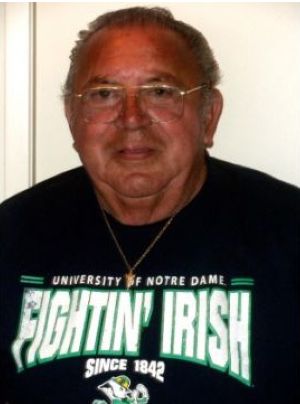 |
Canku Ota
|
 |
|
(Many Paths)
|
||
|
An Online Newsletter
Celebrating Native America
|
||
|
April 2015 - Volume
13 Number 4
|
||
|
|
||
|
Going Irish On The
Reservation
|
||
|
by Gordon Johnson -
Riverside, CA Press-Enterprise Contributing Writer
|
||
|
Despite being
thousands of miles from Indiana, a good number of Pala residents
were big fans of Notre Dame.
I’m 63, a number without fanfare. Too young for the shroud, too old for hip-hop; but I’ve seen some stuff. I’ve lived on the Pala Reservation many years; witnessed many changes. If I close my eyes to see the Pala of my earliest recollections, it’s unrecognizable from the Pala of today. Sure, the Mission survives, as does the Pala Store. The store’s been here more than a century, the Mission more than two. But nearly all of the old houses have been knocked down; replaced with two-story slab-o’-homes. When I was a kid, many of the old two-room shacks, the ones shipped around the Horn in 1903 to house Indian families removed from Warner Springs, still stood. The wooden walls were paper-thin, windows rattled in the wind, and using the facilities meant a hike to the outhouse. Electricity didn’t come to the reservation until the late 1940s and early 1950s. The road from Temecula to Pala didn’t get paved until after World War II. Unlike most reservations that sprawled, the Pala Reservation was laid out like a village, the houses aligned in orderly lots along dirt roads. One street, lined on both sides by outhouses, was called Toilet Street. Most little kids wandered the reservation roads shoeless. The dirt was powdery, and dust flew when you ran and collected between your toes. If left unwashed, toe jam would form. Fences were few. If there was a fence, it was usually chicken wire held upright with dead tree branches gathered from across the San Luis Rey River. With the houses so close to one another, and without fences, a sense of community flourished. To make more room, and to escape the heat in summer, many houses had a lean-to against the side with a wood stove where cooking would happen. You could walk down the road, and smell chicken frying in lard. In another yard, someone might be counting his chickens. People had little money, so they were always home. A birthday, wedding or baptismal meant people would come when invited because there was nothing else to do. Nowadays, many parties are not as well attended because people spend a good amount of time away from home, traveling to Ireland and such. Two of my cousins left for Ireland yesterday. For entertainment, people listened to radios. Sports have always been big on the reservation, so on weekends, radio dials were tuned to sports. And for some reason, Notre Dame was the team of choice, every one rooting for the Irish. I could never understand how a reservation so far from Indiana could generate so many Fighting Irish fans. It wasn’t until much later that I realized radio had done it. Nearly every Pala male of radio-days age had a green pennant, or a ball cap, or a T-shirt with a Notre Dame logo stuffed in a drawer or hanging on a bedroom wall. My uncle, Dennis “Copy” Magee, a huge Notre Dame fan, even visited the campus so he could walk the halls where so many of his sports heroes had walked. The Notre Dame connection made St. Patrick’s Day special. Back in the day, nobody drank green beer. And we didn’t eat much corned beef and cabbage. But the Pala Fighting-Irish fans would don their Notre Dame caps, drink tall cans of Lucky Lager, and eat bean tortilla rolls while biting into a green jalapeño. I appreciate St. Patrick’s Day as well. I plan on celebrating with a black and tan, maybe watching “The Quiet Man,” and for at least for a little while, recalling the St. Patrick’s Days of yesteryear. Happy St. Patrick’s Day all. |
||
|
|
||
|
|
||
| Canku Ota is a free Newsletter celebrating Native America, its traditions and accomplishments . We do not provide subscriber or visitor names to anyone. Some articles presented in Canku Ota may contain copyright material. We have received appropriate permissions for republishing any articles. Material appearing here is distributed without profit or monetary gain to those who have expressed an interest. This is in accordance with Title 17 U.S.C. Section 107. | ||
|
Canku Ota is a copyright ©
2000 - 2015 of Vicki Williams Barry and Paul Barry.
|
||
 |
 |
|
|
The "Canku
Ota - A Newsletter Celebrating Native America" web site and
its design is the
|
||
|
Copyright ©
1999 - 2015 of Paul C. Barry.
|
||
|
All Rights Reserved.
|
||
